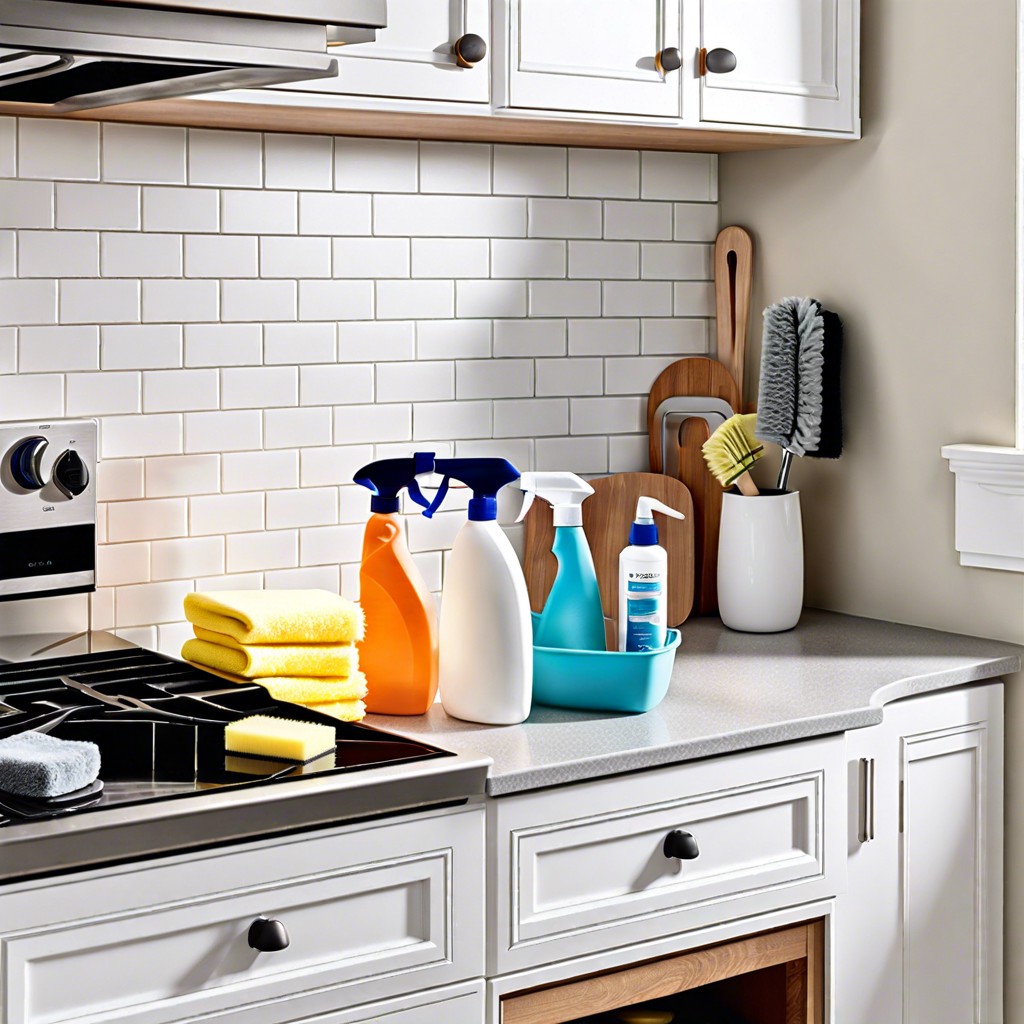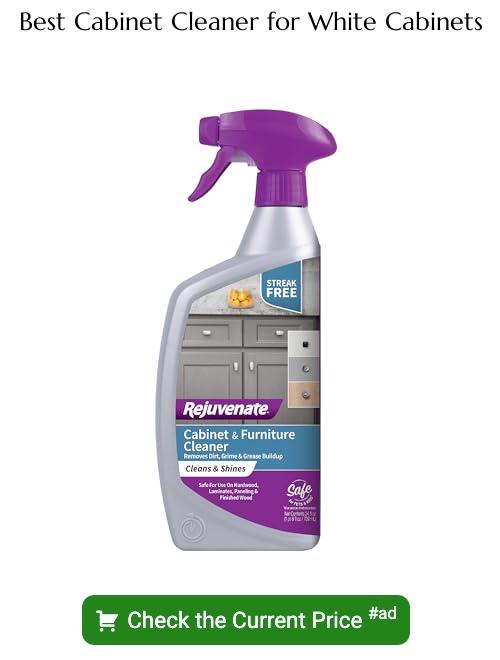Last updated on
Learn the most effective methods for keeping your white cabinets spotless and bright.
Key takeaways:
- Gather essential cleaning supplies: microfiber cloth, sponge, warm water, white vinegar, baking soda, gentle dish soap.
- Clean white cabinets with vinegar and water solution.
- Use vinegar and salt paste or baking soda for stubborn stains.
- Regularly maintain and wipe down cabinets to prevent buildup.
- Prevent grease buildup by using stove vent, covering pots, and wiping cabinets regularly.
What's Inside
Essential Supplies: Gathering the Necessary Cleaning Materials

Before diving into the cleaning process, it’s crucial to have all your materials at hand. A microfiber cloth is a must-have for its gentle yet effective touch on cabinet surfaces. Pair this with a soft sponge for areas needing a bit more attention. Always opt for a non-abrasive option to safeguard the cabinet’s finish.
A bucket of warm water is the foundation of any cleaning solution—not too hot, to prevent warping or damaging the paint, and certainly not cold, which isn’t as effective in dissolving grime.
White vinegar is a stellar choice for a cleaning agent thanks to its natural disinfectant properties. Keep it ready to create a variety of cleaning solutions. In addition, a box of baking soda will be your best friend for tackling more stubborn spots without scratching surfaces.
Lastly, have a bottle of gentle dish soap available. It’s great for cutting through grease and leaves behind a streak-free shine when used correctly. With these items at your disposal, you’re well-equipped to restore the gleaming look of your white cabinets.
Natural Cleaning Power: Cleaning Your Cabinets With Vinegar and Water
Harness the simplicity and potency of vinegar, a powerful natural cleaner, to restore the shine of white cabinets without leaving harsh chemical residues. When diluted with water, it’s effective in breaking down grime and light stains, making it a go-to solution for a gentle yet thorough cleanse.
Begin by mixing equal parts of white vinegar and warm water in a spray bottle. This creates a balanced solution that’s tough on dirt but gentle on most cabinet finishes. For more delicate painted or laminate surfaces, consider a milder concentration by reducing the vinegar.
Dampen a soft, clean cloth with the mixture, wringing out excess liquid to avoid over-wetting the wood. Over-saturation can damage the surface. Wipe down the cabinet doors, drawers, and handles, paying special attention to areas that frequently come into contact with hands, as these spots tend to collect the most dirt.
After swiping the surfaces with the vinegar solution, follow up with a rinse using a fresh cloth and clear, cool water. This step removes any residual cleaning mixture that could potentially attract more dirt if left to dry.
Finally, dry the cabinets with a soft towel to prevent water spots and streaks. This also prevents moisture from seeping into seams and joints, which could swell and damage the wood over time. Your white cabinets will look refreshed, with a natural luster that shines through.
Tackling Stubborn Stains: Using Vinegar & Salt Paste or Baking Soda
When dealing with particularly stubborn stains on white cabinets, a dash of culinary science comes to the rescue. Vinegar, known for its acetic acid content, cuts through grime effectively, while salt acts as a gentle abrasive. A paste made of these two can lift stains without harming the cabinet’s finish. Simply mix equal parts salt and vinegar until a paste forms. Apply it to the stain and let it sit for a few minutes before scrubbing lightly with a soft cloth or sponge.
For those pesky stains that refuse to budge, baking soda steps in as a mild abrasive that’s fantastic at tackling tougher spots without scratching surfaces. Create a paste of baking soda with a bit of water, spread it over the stain, and allow it to set for a few minutes to do its magic. Afterward, scrub gently with a damp, soft cloth, working in a circular motion, then rinse with clean water and dry with a towel.
In both cases, it’s crucial to avoid using steel wool or anything similarly abrasive, as these can scratch and damage the cabinet surface. Remember, gentle persistence is key—patience will keep your white cabinets sparkling without the wear and tear.
Essential Routine: Regular Maintenance and Wiping Down of Your Cabinets
To ensure your white cabinets always look their best, incorporating consistent care into your routine is key. Regular maintenance is less time-consuming than dealing with accumulated grime and extends the life of your cabinets.
Start by dusting weekly with a soft cloth or microfiber duster to prevent dust from building up on surfaces, particularly in grooves and on hardware. For daily touch-ups, a quick wipe with a damp cloth can tackle any splatters or fingerprints that appear, especially after meal prep. Remember to dry the surfaces afterward with a clean towel to prevent water marks.
Additionally, address any spills or stains immediately. The longer they sit, the harder they’ll be to remove, which could require harsher cleaning methods down the line. If you have glass panels on your cabinet doors, a streak-free glass cleaner can keep them sparkling without much fuss.
Every month, take a few minutes to inspect the condition of your cabinets. Tighten any loose handles or knobs to prevent long-term wear and tear. If you notice any chipped areas or places where the paint seems to be thinning, spot-cleaning and touching up these areas will help maintain the pristine white finish.
Incorporating these simple steps into your routine maintains not only the functionality but also the beauty of your white cabinets, ensuring that they remain a bright and welcoming feature in your home for many years to come.
Preventing Grease Buildup: Tips to Keep Your White Kitchen Cabinets Grease-Free
Cooking can often lead to airborne grease, which gradually finds its way onto your white cabinets, creating a grimy layer that dulls their shine. To keep them in pristine condition, it’s crucial to manage this issue at its source. Begin by using a stove vent or exhaust fan while cooking, as this helps to capture a significant portion of the grease before it settles on surfaces.
Another preventive measure is to cover pots and pans when you’re frying or cooking high-grease foods. Opting for lids or splatter screens can dramatically reduce the grease particles that escape into the air.
On a weekly basis, take a few minutes to wipe down the cabinets with a mild detergent solution, making sure to wring out the cloth well to avoid leaving moisture on the cabinets. This regular maintenance removes the possibility of grease hardening over time, which makes it much harder to clean.
Additionally, consider using a silicone cabinet protector on the cabinets closest to the stove. This invisible layer repels grease and grime, making cleanup as simple as a quick swipe with a damp cloth.
By staying proactive and implementing these simple habits into your kitchen routine, your white cabinets will remain as gleaming and welcoming as the day they were installed.





